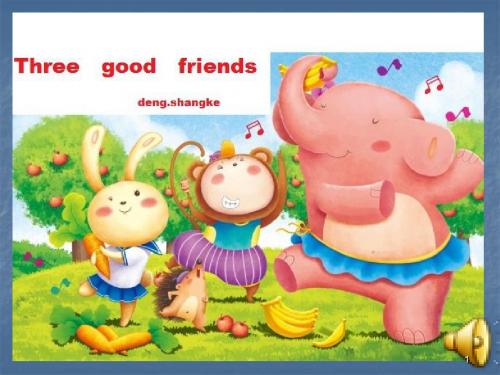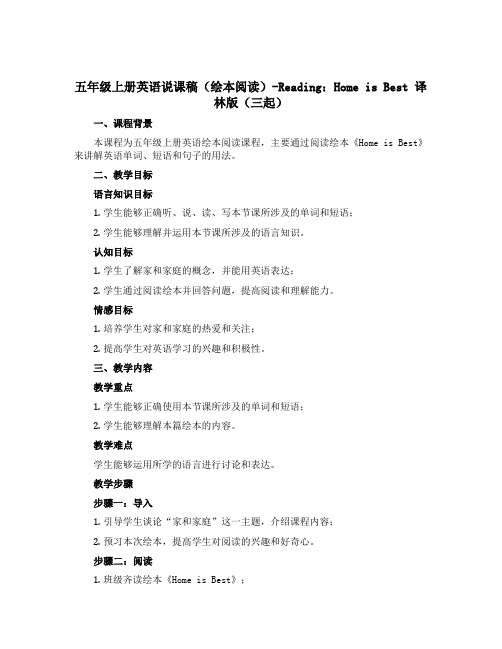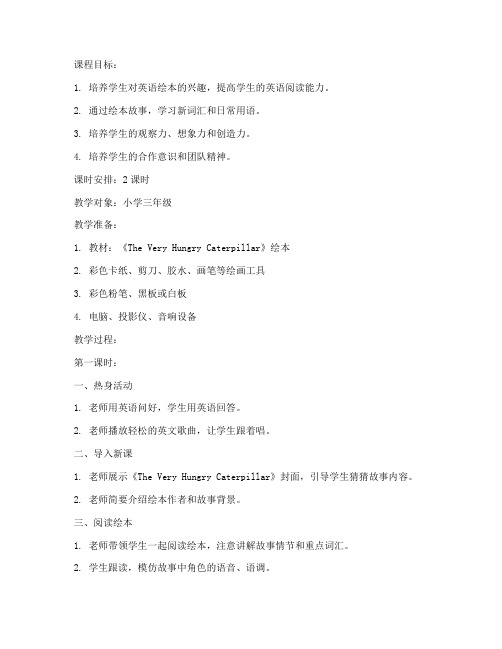小学英语绘本故事.讲课讲稿
小学英语英语绘本教学专题讲座

为什么要进行绘本教学?
《英语课程标准》指出 (二级目标): 能借助图片读懂简单的故事或短文,
并养成按意群阅读的习惯。
思维形 象具体
易被色 彩吸引
注意力 时间短
易被新 奇刺激
易受外 界干扰
无意识记向有 意识记发展
机械记忆向意 识记忆发展
什么是绘本?
文+画 = 有插画的书 文×画 = 绘本(图画书)
Purple hat
Creativity
“紫色思维帽”,启发学生运用他们的想象力 和创造力来给出具体的反馈。
思维帽
问题的设计
思考的层面
解释
White hat Red hat
Facts
“白色思维帽”,引发学生对故事中包含的各 种事实进行理解。
Feelings
“红色思维帽”,需要学生思考故事中人物的 情感发展,以及由故事引发的自己的情感体 验。
表演故事 改编故事 话题讨论 跨学科知识
图画书是成人送给孩子最 好的礼物。
----松居直(日本儿童文学出版专家)
Purple hat
Creativity
“紫色思维帽”,启发学生运用他们的想象力 和创造力来给出具体的反馈。
谁是小小观察员?
Guess what happened to the caterpillar the next day.
根据上文推测,星期四毛毛虫又发生了什么?
?
这次你还能猜对吗?
Guess what happened to the caterpillar the next day.
它要求学生创造性回答或 ✓What will happen next, can you
解决某个问题。
《英文绘本故事》课件

编辑:对翻译后的文字进行编辑,使其符合中文表达习惯,易于理解
校对:对翻译和编辑后的文字进行校对,确保没有错别字、语法错误等
排版:根据绘本故事的内容,对文字进行排版,使其与图片、插画等元素相协调,易于阅 读
绘本故事的图片选择和处理
选择图片:选 择与故事内容 相符的图片, 如人物、场景、 物品等
字体和字号:选择易于阅读的字体和字号,确保课件的易读性和美观性
PPT课件的文字和图片处理
文字处理:选择 合适的字体、字 号、颜色,确保 文字清晰易读
图片处理:选择 与主题相关的图 片,调整大小、 位置,确保图片 与文字协调
动画效果:添加 适当的动画效果 ,使课件更加生 动有趣
排版布局:合理 安排文字和图片 的位置,确保课 件整洁美观
方便快捷:可 以随时随地进 行学习和复习, 不受时间和地 点的限制
02
绘本故事的选择
选择绘本故事的标准和原则
内容丰富:故事内容丰富,能够吸引孩子的注意力
教育意义:故事具有教育意义,能够帮助孩子学习知识、 培养良好的行为习惯
插图精美:插图精美,能够吸引孩子的视觉注意力
语言简单:语言简单易懂,适合孩子阅读和理解
设计精美:PPT课件的视觉效果和设计风格都非常吸引人,能够激发学生 的学习兴趣
互动性强:PPT课件中包含了许多互动环节,能够提高学生的学习参与度 和学习效果
实用性强:PPT课件中的内容可以直接应用于课堂教学,对于教师来说是 非常有价值的教学资源
对未来英文绘本故事PPT课件的发展和展望
技术发展:利用 AR、VR等技术, 增强互动性和沉 浸感
PPT课件的演示和互动功能
演示功能:支持幻灯片播放、动画效果、音频视频播放等 互动功能:支持问答、投票、游戏等互动方式,增加观众参与度 辅助功能:支持笔记、标注、分享等功能,方便观众理解和分享 技术支持:支持多种设备、操作系统和浏览器,保证演示效果和稳定性
儿童英语童话故事演讲ppt课件

1
One day, a monkey rides his bike near the river.
2
This time he sees a lion under a tree.
The lion runs at him.
He is afraid and falls into the river.
8
三个朋友
一天,一只猴子在河边骑车。这时他看见树 下有一只狮子,狮子向他跑来。他非常的 害怕,掉进河里。他不会游泳,大叫起来。 兔子听见了,跳进水里,但他却没有办法 救猴子。幸运的是,一只大象过来了。大 象非常强壮,救出了兔子和猴子。他们来 到大象的家,在那里吃了一顿大餐。从此 他们成了好朋友。
9
He is very strong. He
helps the rabbit and monkey.
6
Three friends are very happy. They go to the elephant’s home.
7
ood friends.
3
He can’t swim. He shouts.
Help me !
4
The rabbit hears him. He jumps into the river.
The rabbit swims to the monkey, but he can’t help him.
5
Luckily, an elephant comes along.
英文绘本讲课逐字稿

英文绘本讲课逐字稿### 教案:英文绘本讲课逐字稿教学目标:1. 学生能够理解并复述英文绘本的主要内容。
2. 学生能够学习并运用绘本中的关键词汇和句型。
3. 学生能够通过绘本内容进行情感态度和价值观的讨论。
教学重点:- 绘本中的关键词汇和句型。
- 绘本内容的理解与复述。
教学难点:- 学生对绘本深层含义的理解和情感态度的表达。
教学准备:- 英文绘本一本。
- 白板和马克笔。
- 绘本相关的图片或实物(如果可能)。
- 学生活动卡片。
教学过程:Step 1: Warm-up (5 minutes)- Greet the students and ask them about their favorite books or stories.- Introduce the topic of today's lesson: "Exploring an English Picture Book."Step 2: Introduction (10 minutes)- Show the cover of the picture book and ask students to predict what the story might be about.- Discuss the title and any words or phrases they find interesting or challenging.Step 3: Vocabulary Building (10 minutes)- Introduce key vocabulary from the story with definitions and examples.- Use pictures or objects to help students understand the new words.- Play a quick game to reinforce the vocabulary, such as "Picture-Word Match" or "Charades."Step 4: Reading the Story (20 minutes)- Read the story aloud to the students, pausing to discuss the illustrations and ask comprehension questions.- Encourage students to follow along in their own copies of the book, if available.- Highlight the sentence structure and any language patterns used in the story.Step 5: Comprehension Check (10 minutes)- After reading, ask questions to check understanding.- Use open-ended questions to encourage students to think critically about the story.- Have students retell the story in their own words.Step 6: Language Practice (15 minutes)- Divide students into small groups and assign them differentparts of the story to act out.- Provide sentence starters to help students practice using the new vocabulary and language structures.- Have each group perform their part for the class.Step 7: Discussion and Reflection (10 minutes)- Lead a class discussion about the story's themes and messages.- Encourage students to share their thoughts and feelings about the characters and events.- Connect the story to real-life situations to help students understand its relevance.Step 8: Closure (5 minutes)- Summarize the main points of the lesson and the story.- Ask students to write a short reflection on what they learned from the story and how it relates to their own lives. - End the class by encouraging students to find and read more English picture books on their own.Homework:- Read another English picture book and write a brief summary or draw a picture that represents the story.Assessment:- Participation in class discussions and activities.- Quality of reflections and homework assignments.通过上述教案,学生不仅能够提高他们的英语阅读和口语能力,还能够通过讨论和反思来深化对故事内容的理解,同时培养他们的批判性思维和创造力。
五年级上册英语说课稿(绘本阅读)-Reading:Home is Best 译林版(三起)

五年级上册英语说课稿(绘本阅读)-Reading:Home is Best 译林版(三起)一、课程背景本课程为五年级上册英语绘本阅读课程,主要通过阅读绘本《Home is Best》来讲解英语单词、短语和句子的用法。
二、教学目标语言知识目标1.学生能够正确听、说、读、写本节课所涉及的单词和短语;2.学生能够理解并运用本节课所涉及的语言知识。
认知目标1.学生了解家和家庭的概念,并能用英语表达;2.学生通过阅读绘本并回答问题,提高阅读和理解能力。
情感目标1.培养学生对家和家庭的热爱和关注;2.提高学生对英语学习的兴趣和积极性。
三、教学内容教学重点1.学生能够正确使用本节课所涉及的单词和短语;2.学生能够理解本篇绘本的内容。
教学难点学生能够运用所学的语言进行讨论和表达。
教学步骤步骤一:导入1.引导学生谈论“家和家庭”这一主题,介绍课程内容;2.预习本次绘本,提高学生对阅读的兴趣和好奇心。
步骤二:阅读1.班级齐读绘本《Home is Best》;2.随机抽取几名学生阅读绘本;3.引导学生讲解生词和短语。
步骤三:理解1.学生回答针对绘本内容的简单问题;2.引导学生讨论绘本中家和家庭的概念和意义。
步骤四:运用1.学生基于所学知识回答针对家庭环境的问题;2.小组合作讨论如何描述自己的家庭,并演示。
步骤五:总结1.总结课程内容,强调学生所学知识;2.鼓励学生学以致用,多多与家人沟通交流。
四、教学评价笔试1.完成本单元的知识点测试;2.详细描述自己的家庭,含家庭成员、住所情况等。
口试1.表达自己对家和家庭的看法;2.讨论与家庭相关的语言主题。
五、教学反思本节课程主要通过阅读绘本《Home is Best》来帮助学生学习家和家庭的概念,并提高其阅读和理解能力。
通过讲解单词、短语和句子的用法,引导学生对语言知识进行理解和运用,同时也为学生提供了锻炼和提高英语口语的机会。
在教学过程中,需要注意引导学生通过小组合作和讨论来分享和交流观点,增强其英语的运用能力和交际能力。
小学绘本课教案模板英语

课程目标:1. 培养学生对英语绘本的兴趣,提高学生的英语阅读能力。
2. 通过绘本故事,学习新词汇和日常用语。
3. 培养学生的观察力、想象力和创造力。
4. 培养学生的合作意识和团队精神。
课时安排:2课时教学对象:小学三年级教学准备:1. 教材:《The Very Hungry Caterpillar》绘本2. 彩色卡纸、剪刀、胶水、画笔等绘画工具3. 彩色粉笔、黑板或白板4. 电脑、投影仪、音响设备教学过程:第一课时:一、热身活动1. 老师用英语问好,学生用英语回答。
2. 老师播放轻松的英文歌曲,让学生跟着唱。
二、导入新课1. 老师展示《The Very Hungry Caterpillar》封面,引导学生猜猜故事内容。
2. 老师简要介绍绘本作者和故事背景。
三、阅读绘本1. 老师带领学生一起阅读绘本,注意讲解故事情节和重点词汇。
2. 学生跟读,模仿故事中角色的语音、语调。
四、词汇学习1. 老师引导学生找出绘本中的新词汇,如:fruit、caterpillar、chrysalis等。
2. 学生用卡片游戏复习新词汇,如:单词接龙、你画我猜等。
五、总结与拓展1. 老师引导学生总结故事主题,如:勤奋、坚持、成长等。
2. 学生发挥想象力,用绘画形式表现故事情节。
第二课时:一、复习导入1. 老师用英语提问:“Do you remember the story of The Very Hungry Caterpillar?”2. 学生用英语回答,复述故事情节。
二、小组活动1. 将学生分成若干小组,每组准备一幅表现故事情节的画。
2. 学生用彩色卡纸、剪刀、胶水等工具制作画。
3. 小组成员互相帮助,共同完成画作。
三、展示与评价1. 各小组展示自己的作品,讲述画作背后的故事。
2. 老师和学生共同评价各小组的作品,评选出“最佳创意奖”、“最佳合作奖”等。
四、总结与反思1. 老师引导学生回顾本节课所学内容,总结绘本故事的主题。
儿童英语童话故事演讲ppt课件

Luckily, an elephant comes along.
He is very strong. He
helps the rabbit and monkey.
6
Three friends are very happy. They go to the elephant’s home.
9
7
Then, three of them become good friends.
8
三个朋友
一天,一只猴子在河边骑车。这时他看见树 下有一只狮子,狮子向他跑来。他非常的 害怕,掉进河里。他不会游泳,大叫起来。 兔子听见了,跳进水里,但他却没有办法 救猴子。幸运的是,一只大象过来了。大 象非常强壮,救出了兔子和猴子。他们来 到大象的家,在那里吃了一顿大餐。从此 他们成了好朋友。
He is afraid and falls into the river.
3
He can’t swim. He shouts.
Help me !4 The rabbit hears him. He jumps into the river.
The rabbit swims to the monkey, but he can’t help him.
兔子听见了跳进水里但他却没有办法兔子听见了跳进水里但他却没有办法救猴子
Deng.shangke
1
One day, a monkey rides his bike near the river.
2
This time he sees a lion under a tree.
The lion runs at him.
小学英语绘本教学课件

小学英语绘本教学课件(总5页)--本页仅作为文档封面,使用时请直接删除即可----内页可以根据需求调整合适字体及大小--小学英语绘本教学课件小学英语绘本教学课件一、学生分析本节课的教学对象是小学三年级的学生。
他们的年龄在九岁左右,生性活泼好动,喜欢直观形象思维,对游戏、竞赛、特别感兴趣。
学生学英语不久,有的可能说得不好,有的还不敢说,课堂上应以表扬为主,注重培养学生学习英语的兴趣,鼓励他们大胆说、积极做、努力唱。
学生们喜新好奇,求知欲强,对于新鲜的事物有着浓厚的兴趣和探究欲望。
他们已经学过一些简单、常见的动物单词,如dog、cat、monkey等。
同时,应抓住学生喜爱动物这一有利因素,加强对学生进行环保教育。
二、教材分析1.Let'slearn本部分是本册书Unit4Weloveanimals的第二课时,课前学生已学习动物名称:rabbit,panda,monkey,会说表示赞美的词语Super!Cool!Great!等。
2.Let'sdo本部分是为了巩固Let'slearn部分的内容,并培养学生学习英语的兴趣而设计的。
学生可以在此项活动中尽情发挥表演才能,看谁模仿的动物形体特征最逼真,学的动物声音最像。
三.教学目标1.能力目标能听、说、认读一些常见的动物单词cat,dog,monkey,duck,panda,rabbit,并能用英语介绍这些小动物。
能听懂一些简单的指示语,并能按照指令模仿动物做出相应的动作。
2.情感目标培养学生爱护动物、保护动物的意识。
四.教学准备可爱的动物玩具、多媒体课件、单词卡片、动物头饰、大红萝卜道具。
五.教学过程1.Warm-up(1)Freetalk(1分钟),Fangfang.----Goodafternoon,Lanlan.,----Hi,I'mfine,----Verywell,thankyou.(2)播放歌曲TeddyBear(要求学生边拍手边吟唱,营造一个欢乐活泼的英语气氛。
